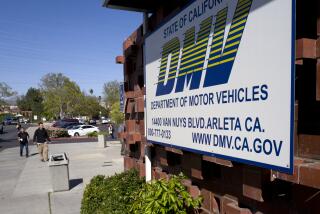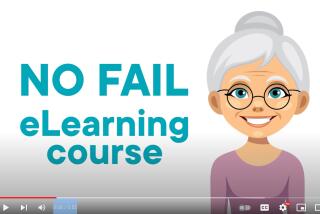With New Law, 16 Isn’t So Sweet
Vicky Vosk got her red Nissan truck, the one she always wanted, on her 16th birthday. It was supposed to be the culmination of a childhood master plan: She would get her driver’s license that day, marking the start of an era of independence from her parents.
But today her truck sits in the garage, banned from being used in any type of cruising expedition with friends. Because of a new law in California, Vosk has put on hold her long-awaited freedom at the wheel, joining a generation of California teenagers who must pay their dues before obtaining full driving privileges.
“It’s frustrating. With the old law, everyone was looking forward to the day they turned 16. Now you have to wait so long to get your license,” she said.
The Teen Driver Safety Act, which took effect in July 1998, targets teenage drivers because they constitute the group at highest risk of being in an accident.
Previously, a teenager who passed the written test and got a learner’s permit could have a full license as quickly as 30 days after passing a driving test. The new law, however, phases in driving privileges in three stages:
* The learner’s permit stage, which now lasts six months, begins after a driver passes a written test. During this period, teenagers are allowed to drive only with an adult 25 or older and must complete 50 hours of supervised driving.
* The provisional license stage, which comes after passing a driving test and lasts until the teenager turns 18. During the first six months of this phase, teenagers are allowed to drive on their own, but can’t transport any passengers under 20 without someone 25 or older in the car. In addition, they are not allowed to drive between midnight and 5 a.m. unless accompanied by a driver 25 or older.
* The full license stage starts at 18 and carries no restrictions.
Many teenagers are upset with these regulations.
“There are too many restrictions,” said 17-year-old Tony Morales of North Hollywood. “It was a good idea to keep the streets safer from crazy teenagers, but it screwed up people who do need a car for important necessities.”
Not being able to drive with friends unless an adult is in the car means postponing the quintessential ride to the mall in a pack.
“It’s kind of too long to wait to be able to go out with your friends,” said 15-year-old Courtney Porter, who was taking the written test recently at the Department of Motor Vehicles office in Canoga Park.
Others criticize the nighttime restrictions.
“What if I go to a party and have to drive home late? I don’t see what’s wrong with that as long as there’s no alcohol,” said 16-year-old Tony Cabrera, a junior at Hollywood High School.
Dramatic Drop in Accident Rate
Even though teenagers have expressed their frustration at the new regulations, the law has already had a significant impact. For the first six months of this year, fatal and injury accidents caused by teenage drivers dropped 12% for 16-year-olds and 18% for 15-year-olds (the age of many teenagers with learner’s permits), compared to last year when the law was not yet in effect, according to the latest preliminary figures from the California Highway Patrol.
“Those are wonderful numbers. Hopefully this means the law will save lives, and that’s what we’re after,” said Carol Thorp, director of public relations at the Automobile Club of Southern California, which pushed for the law.
The reduction in teenage-related accidents mimics results obtained in states with similar programs. California is one of 34 states with regulations to slowly introduce teenagers to the complexities of the road.
These systems, generically known as graduated licensing programs, have been enacted in many states because young drivers are disproportionately involved in car crashes. Vehicle crashes are the No. 1 cause of death for teenagers, accounting for almost a third of all deaths for the age group, according to the Automobile Assn. of America.
And crashes involving teenagers, especially 16-year-olds, are often different from than those involving older drivers, says the Insurance Institute for Highway Safety. Sixteen-year-olds get into trouble handling emergencies or unusual situations, and very often lose control of their vehicles, according to the institute.
That’s what happened to 16-year-old Marco Relis of Orange County last February. Driving at more than 100 mph on the San Joaquin Hills toll road, he lost control and slammed into an oncoming car, according to the CHP. Relis died, along with a mother and child in the other car. He was driving with a 15-year-old friend and had just gotten his provisional license a few weeks earlier, so he should have been driving with an adult in the car, CHP officials said.
Inexperience at the wheel and immaturity make for a dangerous combination, and result in approximately 6,000 deaths and 600,000 injuries each year.
Dan Binetti, who has been teaching driver education for 25 years and currently does so at Hollywood High School, says teenage drivers showing off for their friends is a major cause of accidents.
“One of the first things kids do is pick up their friends. You gotta go cruising around town.”
Peer pressure can make teenagers act irresponsibly, he said. “They’d be embarrassed not to rip out or take a challenge if somebody wanted to race.”
Some teenagers recognize that the new regulations are designed to protect them. At Canoga Park High school, several students said they support the restrictions that come with a provisional license. “It’s better because we don’t have uncontrolled teenagers making a mess of things,” said Crystalin Robbins, 15, of Winnetka. “Some of them don’t like it because they can’t do what they want to do. I kind of like it because now I will feel safer driving at night.”
Robbins says she does not want to drive until she is 17 or 18. “You’re not mature enough at 16 to be responsible for driving correctly,” she said.
Others know firsthand about the dangers of teenage driving. One is Andrea Leon, who wants to wait until she is 17 to take driving lessons. The 15-year-old lost her eagerness to drive after her teenage cousin was in a car accident that left her in a coma less than a month ago.
“I don’t even want to think about driving,” Leon said. “I used to think, ‘When I’m 16 I want to get my car.’ I’m kind of scared about it.”
But even as numbers suggest that the new law is having an impact, many teenagers are simply ignoring the regulations and driving with friends without the full license.
“Most people wait like a month, two months, and then they say ‘forget it,’ ” said one teenager at Fairfax High School.
“Yeah, most people do it. C’mon, who doesn’t do it? Everybody does it,” said Vosk, who attends the same school.
Officers Often Don’t Cite Violators
David Searcy, supervising referee of the informal Juvenile and Traffic Court in Los Angeles, is aware of the trend. He said police officials commonly encounter teenage drivers who are violating the new law. But it’s hard to reliably track those numbers; officers often don’t cite teenagers for those violations, and instead simply warn them. Further, an officer is not supposed to stop a teenager who is driving with other teens in the car unless another violation is observed, such as running a red light or not wearing a seat belt, he said.
DMV spokesman Evan Nossoff said it is no surprise that teenagers with permits or provisional licenses are driving with friends while unsupervised by adults.
But he added that the law still works, albeit for a different reason: “The law is going to have an impact not necessarily because [teenagers] are following the rules, but because they fear for the consequences,” and drive more cautiously, he said.
In general, parents are supportive of the regulations, said Kathleen Marvaso, director of state relations at AAA, the national auto club. Still, some call the new rules inconvenient because they want their children to drive themselves to school or work.
Myra Lincow is one parent who doesn’t see the point of all the restrictions against teenage drivers, even though her 17-year-old daughter Pamela supports them.
Lincow, 32, of Canoga Park said she is a single mother and has little time to give her daughter rides or to supervise her driving.
“When you’re a teenager, you want that independence. How can you feel proud if you have all these restrictions?” she said. But she acknowledges that hers is a minority view among parents. “I may be a lone ranger in my feelings about this.”
One widespread feeling among parents and their teenagers is that the required 50 hours of supervised driving might be hard to accomplish.
During Binetti’s driver ed class one morning, all the students expressed skepticism that their parents would spend that much time driving with them.
“Our parents aren’t going to take time out of their busy schedules to drive with us,” said 16-year-old Stephanie Trigg.
Gloria Tuutau, whose son Daniel takes driver ed with Binetti, said she doesn’t think the state should mandate the number of hours parents must drive with their children.
“It’s ultimately the parents’ responsibility to make sure they know how to drive,” she said. “If there are two children in the same family, maybe one needs less than 50 hours and one needs more. The parents know how much they need, or if they don’t, they should.”
But according to the Insurance Institute for Highway Safety, the 50 hours look less daunting when viewed over the entire six months. The requirements translate to 8.3 hours per month, or roughly two hours per week.
And 50 hours of supervised driving does not mean parents must take their kids through an endless tour of a mall’s parking lot, Marvaso said. It means parents should take their children to drive on the highway or to experience varying weather conditions.
“It’s such a high, high risk for teens to drive before they are prepared that [the law’s benefits] outweigh the risks,” Marvaso said she tells parents. “Believe us, it’s worth it.”
One good piece of news for those teenagers who are worried about their social life is that graduated licensing programs do not appear to significantly hinder the social activities of youngsters. Several studies show that 16-year-olds have similar lifestyles when it comes to dating, social and work patterns, whether or not they live in states with graduated licensing programs, a report from the Insurance Institute for Highway Safety says.
And in California, as with many other states, teens who absolutely need to drive during restricted times--to go to work or school activities, for example--may obtain a waiver from their principal or guardian.
The bottom line, Thorp said, is that the law was not designed to punish teenagers. Its intent, which seems to be taking effect already, is far from punitive: “To make sure they stay alive to drive another day.”
Times staff writers Roberto Manzano and Hudson Sangree contributed to this story.
(BEGIN TEXT OF INFOBOX / INFOGRAPHIC)
Putting On the Brakes
A 1998 state law that restricted driving privileges for new 16- and 17-year-old drivers was aimed at reducing vehicular crashes and fatalities. Results for the first half of 1999 show a decline in the number of fatal and injury accidents caused by teenagers compared to the same period last year, before the law went into effect.
*--*
Age of Driver 1998 1999 % change 15 177 145 -18.1% 16 1,940 1,706 -12.1% 17 2,659 2,502 -5.9% Total 4,776 4,353 -8.9%
*--*
Source: California Highway Patrol
More to Read
Sign up for Essential California
The most important California stories and recommendations in your inbox every morning.
You may occasionally receive promotional content from the Los Angeles Times.








